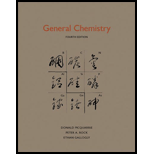
Concept explainers
Interpretation:
Whether heating of
Concept Introduction:
Molar enthalpy for a process is the quantity of heat energy needed by one mole of a substance to undergo change in the process. The heat energy absorbed by n mole of substance to undergo change is as follows:
Here,
The value of
The formula to calculate the time required to transfer heat energy is as follows:
Answer to Problem 15.10P
The heating of
Explanation of Solution
The formula to calculate the number of moles of water is as follows:
Substitute
The value of
The value of
The temperature difference (
The size difference on kelvin and Celsius scale is equal so
The formula for heat energy involved in heating
Substitute
The formula to calculate the time required to transfer heat energy is as follows:
Substitute
The formula for heat energy involved in heating
Substitute
The total energy that must be absorbed by
The total energy that must be absorbed by
Substitute
Therefore vaporization of
Want to see more full solutions like this?
Chapter 15 Solutions
General Chemistry
 ChemistryChemistryISBN:9781305957404Author:Steven S. Zumdahl, Susan A. Zumdahl, Donald J. DeCostePublisher:Cengage Learning
ChemistryChemistryISBN:9781305957404Author:Steven S. Zumdahl, Susan A. Zumdahl, Donald J. DeCostePublisher:Cengage Learning ChemistryChemistryISBN:9781259911156Author:Raymond Chang Dr., Jason Overby ProfessorPublisher:McGraw-Hill Education
ChemistryChemistryISBN:9781259911156Author:Raymond Chang Dr., Jason Overby ProfessorPublisher:McGraw-Hill Education Principles of Instrumental AnalysisChemistryISBN:9781305577213Author:Douglas A. Skoog, F. James Holler, Stanley R. CrouchPublisher:Cengage Learning
Principles of Instrumental AnalysisChemistryISBN:9781305577213Author:Douglas A. Skoog, F. James Holler, Stanley R. CrouchPublisher:Cengage Learning Organic ChemistryChemistryISBN:9780078021558Author:Janice Gorzynski Smith Dr.Publisher:McGraw-Hill Education
Organic ChemistryChemistryISBN:9780078021558Author:Janice Gorzynski Smith Dr.Publisher:McGraw-Hill Education Chemistry: Principles and ReactionsChemistryISBN:9781305079373Author:William L. Masterton, Cecile N. HurleyPublisher:Cengage Learning
Chemistry: Principles and ReactionsChemistryISBN:9781305079373Author:William L. Masterton, Cecile N. HurleyPublisher:Cengage Learning Elementary Principles of Chemical Processes, Bind...ChemistryISBN:9781118431221Author:Richard M. Felder, Ronald W. Rousseau, Lisa G. BullardPublisher:WILEY
Elementary Principles of Chemical Processes, Bind...ChemistryISBN:9781118431221Author:Richard M. Felder, Ronald W. Rousseau, Lisa G. BullardPublisher:WILEY





